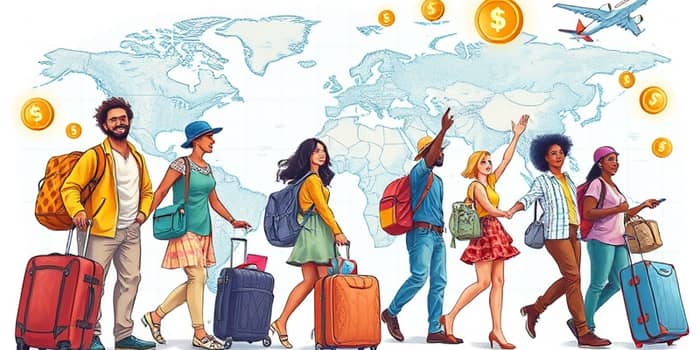
In a world where experiences define our lives, unsecured, quick-access personal loans have emerged as a powerful tool to fund unforgettable journeys. With global tourism rebounding and travelers seeking new horizons, the personal lending landscape has adapted to meet growing demand. From the pristine beaches of Bali to the historic streets of Rome, millions now rely on structured financing to turn aspirations into reality.
The Global personal loans market is on an extraordinary trajectory, surging from an estimated $429.78 billion in 2025 to over $1,094.77 billion by 2032. This expansion reflects a robust compound annual growth rate of 14.3%, fueled by enhanced digital platforms and wider access to credit products.
Asia-Pacific leads the charge, with projections of $102.35 billion in personal loans by 2025. Countries such as India ($26.05B), China ($33.64B), and Japan ($15.23B) drive this trend, thanks to rising incomes and stronger digital financial literacy. Meanwhile, South America, led by Brazil and Argentina, anticipates $30.45 billion in the same period, overcoming challenges like high inflation and historical banking dominance.
Across continents, travel now ranks as the leading purpose for personal borrowing, overtaking home renovations and healthcare. In India alone, 27% of personal loan borrowers in the first half of 2025 used funds for holidays—up from 21% in 2023. More than 30 million Indians traveled abroad in fiscal 2024, spending nearly $17 billion overseas in FY25.
This phenomenon extends to the US, Ireland, Germany, and Kuwait, where leisure financing has become mainstream. Younger generations—Millennials and Gen Z—are especially active, preferring to spread costs over manageable equated monthly installments. Notably, 71% of holiday loan applications now originate from tier-2 and tier-3 cities, illustrating broader financial inclusion beyond metropolitan hubs.
Travel loans are typically unsecured, quick-access personal loans that require minimal collateral and feature rapid digital approval processes. Their main attractions include:
Borrowers can tailor repayments through competitive products offered by banks, credit unions, and a burgeoning array of fintech platforms.
Understanding the fixed or floating interest rates is crucial to managing the true cost of a travel loan. Annual Percentage Rates (APRs) in 2025 vary widely:
Below is a sample cost breakdown for a $5,000 loan over five years in the United States:
Financial experts advise shorter terms to minimize interest paid overall, though this demands higher monthly installments. Conversely, extended tenures reduce monthly strain but increase the total cost.
Millennials and Gen Z now form the backbone of travel finance, drawn by aspirational experiences and once-in-a-lifetime bucket list vacations. Their borrowing patterns emphasize digital research, seamless online applications, and transparent fee structures.
Self-employed professionals, however, face strict eligibility criteria for self-employed individuals, often requiring more extensive documentation. Salaried workers with strong credit profiles enjoy preferential rates, while newcomers to credit must balance higher APRs against their passion for exploration.
Regional differences shape travel-loan dynamics. In India, non-metro cities fuel record growth in holiday borrowing, underpinned by rising discretionary incomes and smartphone penetration. Asia-Pacific’s youth-driven markets lean heavily on mobile lending applications, while South America witnesses fintech challengers eroding traditional banking monopolies.
In the US and Europe, “vacation loans” are packaged explicitly for travel, with lenders offering perks like partner discounts and concierge services. As outbound travel rebounds globally, these personalized financing solutions stimulate tourism and support local economies.
Prospective travelers should adopt a disciplined approach before signing on the dotted line. Recommended steps include:
Prudent borrowing can transform a dream vacation into a stress-free reality, provided travelers remain mindful of their long-term financial goals.
Travel loans offer undeniable advantages: they expand access to global experiences and enable budget predictability through fixed repayments. Yet, they carry inherent risks. High-interest rates for subprime borrowers can inflate trip costs, while missed EMIs damage credit scores and trigger penalties.
Looking ahead, the convergence of fintech innovation and evolving consumer preferences portends continued growth. Financial literacy initiatives and regulatory frameworks will be vital to safeguard borrowers. As digital ecosystems mature, we can expect more tailored products, real-time approvals, and AI-powered risk assessments that balance opportunity with responsibility.
In conclusion, personal loans for travel are reshaping the fabric of global tourism, enabling more people than ever to explore distant lands. By understanding market trends, cost structures, and regional intricacies, aspirational travelers can leverage these financial tools to craft enriching journeys—while safeguarding their financial health for adventures yet to come.
References













